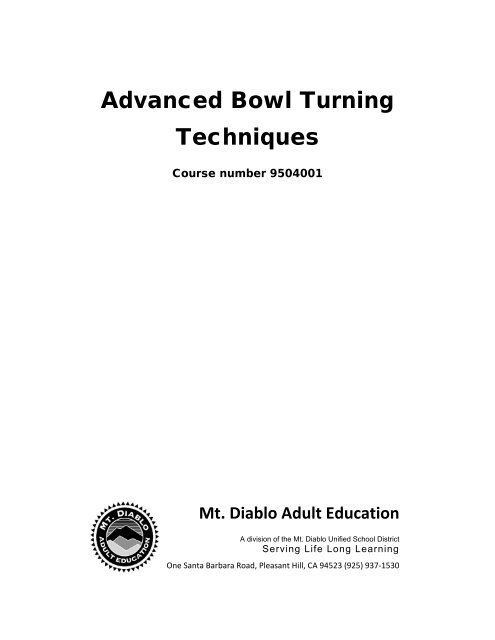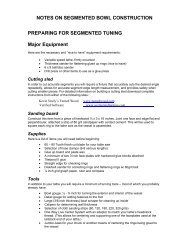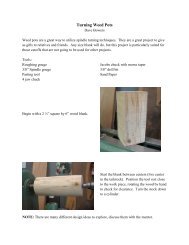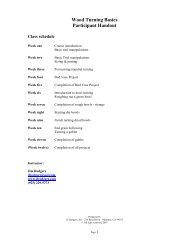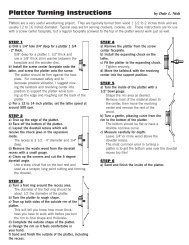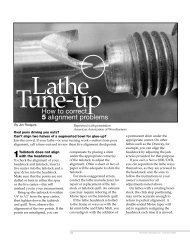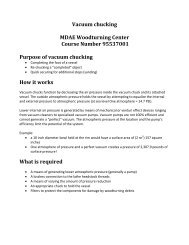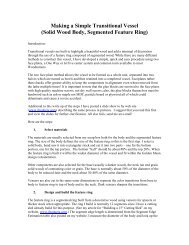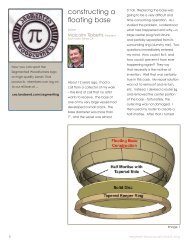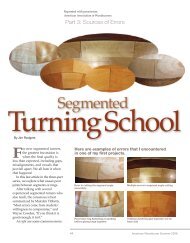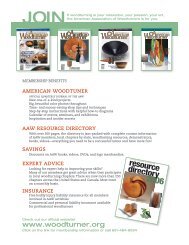Advanced Bowl Turning Techniques
Advanced Bowl Turning Techniques
Advanced Bowl Turning Techniques
You also want an ePaper? Increase the reach of your titles
YUMPU automatically turns print PDFs into web optimized ePapers that Google loves.
<strong>Advanced</strong> <strong>Bowl</strong> <strong>Turning</strong><br />
<strong>Techniques</strong><br />
Course number 9504001<br />
Mt. Diablo Adult Education<br />
A division of the Mt. Diablo Unified School District<br />
Serving Life Long Learning<br />
One Santa Barbara Road, Pleasant Hill, CA 94523 (925) 937‐1530<br />
1
Rules of classroom conduct<br />
Always maintain a safe work environment for yourself and others<br />
o Always wear safety glasses or face shields as required<br />
o Advise instructor of any safety concerns or issues<br />
Clean up at the end of each class<br />
o Your work area/lathe<br />
o The class room floors and tables<br />
o Sharpening center<br />
o Replace all tools/accessories into the proper location<br />
Always sign in on arrival<br />
o Advise instructor if you plan on leaving early<br />
Be responsible for your own personal tools/equipment<br />
2
Woodturning Safety Rules<br />
1. Know Your Equipment and Yourself. Never operate a lathe or use a cutting tool, chuck or other accessory<br />
without first understanding its operation and limitations. Read and know the instruction manual of any lathe that<br />
you use. Never perform a procedure or technique that you are unclear about or uncomfortable with. If you are in<br />
doubt, stop and ask for instruction. Know your personal limitations.<br />
2. Focus on Your Work. You may not operate a lathe if you have drunk alcohol or taken medication that carries an<br />
equipment operations warning. Don’t operate a lathe if you are tired or emotionally upset.<br />
3. Police Your Environment. Keep your work area clean. Store tools safely. Don’t allow cords to run across<br />
circulation ways. Don’t start your lathe if people are in harm’s way. Ensure that there is adequate light and<br />
ventilation. If you are observing someone else, don’t place yourself in harm’s way.<br />
4. Keep Yourself Catch Free. Long hair must be tied back. No clothing, gloves, jewelry or watches may be worn<br />
below the elbow. Necklaces and loose clothing that could be caught by spinning parts must not be worn.<br />
5. Wear Safety Equipment. To operate a lathe or stand near an operating lathe, you must wear full face<br />
protection. Dust masks are highly recommended.<br />
6. Secure the Wood. Ensure that the wood is securely held. Turn between centers whenever possible and always<br />
with imbalanced pieces. Use a slow speed when first roughing out a piece. Never use wood that is cracked or has<br />
other serious defects or significant protrusions.<br />
7. Inspect Your Lathe. Inspect the lathe for damaged or missing parts before operating it. Before you start, check<br />
to ensure that the speed is appropriate, the drive belt is tight, all locking devices are secure and all chuck keys and<br />
adjusting wenches are removed. Always spin the wood at least one full turn before turning the lathe on ‐ every<br />
time. Never leave a spinning lathe unattended.<br />
8. Practice Safe <strong>Techniques</strong>. Keep your tools sharp. Don’t force a tool or use it for an unintended purpose.<br />
Reposition the tool rest frequently to keep it close to the work. Keep your balance and don’t overreach. Always<br />
turn the lathe off and allow it to come to a complete stop before adjusting the tool rest. Always keep your hands<br />
behind the plane of the tool rest. Always keep the tool firmly against the tool rest. Always hold the tool firmly<br />
with both hands.<br />
When using a shear cut, rub the bevel. When using a scraping cut, always keep the angle between the wood and<br />
cutting edge at less than 90 degrees.<br />
When finishing, always remove the tool rest. Use only paper towels, never woven fabric. On exterior surfaces,<br />
apply the towel to the underside of the piece with the wood spinning counterclockwise. On interior surfaces, apply<br />
the towel in the lower left‐hand quadrant also with the wood spinning counterclockwise.<br />
Adopted by Bay Area Woodturners Association, 10 March, 2001<br />
3
Direction of cuts<br />
When making cuts we try to cut “downhill to the grain.” This is the direction in which the fibers being<br />
cut are more supported by the un‐cut fibers below. The supported fibers cut more cleanly resulting in<br />
less tear out, smoother cuts and the final effect – less sanding.<br />
In spindle turning “down hill” is towards the center of the work. In bowl turning “down hill” will be a<br />
function of how the blanks is oriented on the lathe. Most side grain bowls appear as indicated in the<br />
illustration. In end grain vessels the down hill cut is similar to cutting in spindle turning, e. g., towards<br />
the center of rotation.<br />
4
Working with Trees<br />
One of the best sources of wood for turning bowls is the “urban forest.” Trees cut in our neighborhoods<br />
and properly processed are constant sources of turning stock. Tree trimmers and arborists do not<br />
generally cut trees into pieces suitable for wood turners so it is helpful for you to be present when the<br />
tree is cut down or trimmed. Many local hardwood species can be perfect bowl blanks whereas most<br />
non‐deciduous varieties are not so good. It is an interesting challenge for the new turner to learn which<br />
local species work the best.<br />
The illustrations below depict the steps in cutting bowl blanks and storing them until you are ready to<br />
turn. Quick handling is most important in the warmer months when the wood dries too rapidly. If the<br />
wood is not processed with speed, the drying will cause the wood to split and make it unusable.<br />
Here are the steps to harvesting turning blanks from the urban forest:<br />
<br />
Cut the tree into log sections approximately<br />
20% longer than the tree is in diameter thus allowing for some<br />
checking on the ends before the wood is completely processed.<br />
Cut logs 20% longer than their<br />
diameter.<br />
<br />
Seal the ends of each log section with a wax solution if the wood<br />
will not be processed immediately. Other end grain sealing<br />
agents also will work such as inexpensive or surplus latex house<br />
paint (your color choice).<br />
If you don’t process the logs<br />
immediately, seal the ends.<br />
<br />
To prepare and store the bowl blanks created from the log<br />
sections stand the log section on end and locate the pith of the<br />
log (the center of growth). Rotate a straight edge around the<br />
pith examining the log to locate two portions that appear to be<br />
as symmetrical as possible and mark a line along that axis.<br />
Find the symmetry through the<br />
log’s pith.<br />
<br />
Cut the log into two portions along the marked line bypassing<br />
the pith on both sides. The pith of the tree is unstable or dead<br />
wood and must be excluded from the bowl blanks to keep them<br />
from splitting.<br />
Cut along the symmetry line on<br />
both sides of the pith.<br />
<br />
Re‐seal the ends with a wax solution or latex paint end grain<br />
sealer to prevent rapid moisture loss from the bowl blanks. Store<br />
the cut bowl blanks in a cool, airy location until they are rough<br />
turned. Allow for air circulation to prevent mold accumulation<br />
on or in the bowl blanks.<br />
5<br />
Store the prepped blanks in a<br />
cool, airy location.
Principle features of a tree stem, cross‐sectional view.<br />
<br />
<br />
<br />
<br />
<br />
<br />
<br />
<br />
H 2 0 + CO 2 + nutrients = C 6 H 12 O 6 (Glucose) + O 2 in the presence of Chlorophyll & sunlight in the<br />
leaves<br />
The inner bark transports the glucose to where growth take place,<br />
o Roots and stem tips<br />
o The Cambium layer creates new sap wood by forming cellulose and hemi cellulose from sugars<br />
o Cellulose forms longitudinal tracheids – the tubular vertical structures<br />
Lignin surrounds the longitudinal tracheids and stiffens and holds them together<br />
o Lignin is thermoplastic<br />
o Grass has no lignin – no stiffness<br />
o Cotton is almost pure cellulose<br />
Transverse cells or rays transport materials between growth rings<br />
Heart wood is where the tree stores the extractives,<br />
o Lignins, waxes, tannins, gums, terpenes, oils, fats, etc<br />
Dry weight of wood is composed mostly of<br />
o Cellulose – 50 %<br />
o Hemi cellulose – 13 to 25%<br />
o Lignin – 15 to 30%<br />
o Extractives – 2 to 15%<br />
Hardwood trees<br />
o Are generally deciduous trees and drop their leaves in winter<br />
o Have a broad leave structure<br />
o Are angiosperms (seeds enclosed in a fruit or nut)<br />
o Have a more complex cell structure<br />
Softwood trees<br />
o Most common are conifers or cone bearing<br />
o Are gymnosperms producing “naked seeds”<br />
o Leaves are needles or scales<br />
o Generally non‐deciduous<br />
6
Wood movement<br />
Tangential<br />
Movement<br />
Radial<br />
Movement<br />
Wood species % Radial shrinkage % Tangential shrinkage<br />
Domestic hardwoods<br />
Ash, white 4.9 7.8<br />
Poplar 3.0 7.1<br />
Elm, American 4.2 9.5<br />
California laural 3.0 9.0<br />
Madrone, Pacific 5.6 12.4<br />
Maple, Silver 3.9 7.2<br />
Mesquite 2.2 2.6<br />
Oak, Live 6.6 9.5<br />
Tanoak 4.9 11.7<br />
Walnut, Black 5.5 7.8<br />
Domestic softwoods<br />
Cedar, Western red 2.4 5.0<br />
Douglas fir, Coastal 4.8 7.6<br />
Pine, Western White 4.1 7.4<br />
Redwood, Young growth 2.2 4.9<br />
Imports<br />
Bubinga 5.8 8.4<br />
Cocobolo 3.0 4.0<br />
Purpleheart 3.2 6.1<br />
Rosewood, Brazilian 2.9 4.6<br />
7
Working with green wood blanks<br />
First step: Rough turning green wood bowl blanks<br />
Green wood blanks are heavier due to the water content and more prone to shaking the<br />
lathe. Keep the lathe speed to its lowest setting until you know that the blank has been<br />
turned sufficiently to bring it into better balance. You will spend a large portion of the<br />
roughing out process is just getting the blank balanced and round.<br />
Safety at all times requires the turner to wear a full face shield during this phase as there is<br />
always the possibility of flying bark or wood coming off the lathe.<br />
<br />
<br />
<br />
<br />
For a standard finished edge bowl, mount the green blank with the bark toward the<br />
tailstock. Cut away the bark where the live center is to be fitted in order to have a<br />
better hold on solid wood.<br />
The water and sap from green blanks will easily rust your lathe so take precautions<br />
by waxing the ways, tool rest, and banjo. Also clean up soon after completing the<br />
roughing out process.<br />
Roughing out is the process of initially turning the green blank into its general shape<br />
before allowing it to dry. The bowl blank can be mounted on a screw chuck as we<br />
did in the last exercise for initial turning, or between centers using a spur drive in<br />
the headstock. If you mount between centers, recheck the tightness regularly as the<br />
fibers compress and the hold loosens over time.<br />
When adding the tenon before roughing out the interior be sure that the tenon is in<br />
solid wood including no bark since bark won’t hold. Also make the tenon larger than<br />
initially needed as it will be reduced later when the bowl is turned the second time.<br />
<br />
Hollow the interior allowing for a wall thickness<br />
Rough out the bowl blanks to a wall<br />
of 10% of the total diameter or 1” thickness. thickness of about 10% of the diameter.<br />
This is necessary to allow for the distortion<br />
during the drying phase that will naturally<br />
occur. The wall thickness must be uniform from top to bottom. Uneven wall<br />
thickness will allow drying in the thinner areas more rapidly than in the thicker<br />
areas causing added strain and potential cracking.<br />
8
Second step: Sealing, storing & drying<br />
The roughed out blank is sealed on all surfaces with a wax solution, latex house<br />
paint, or any material that will reduce the rate of drying. Most important is to seal<br />
the end grain areas inside and outside as moisture will be more rapidly lost through<br />
these areas.<br />
Roughed out blanks should be stored in a cool<br />
Seal and store rough bowl blanks<br />
location with good air circulation so that the<br />
until dry.<br />
drying can proceed slowly and evenly. The<br />
drying process can be checked by weighing the<br />
blank and noting its weight periodically. When the weight loss stops, the blank will<br />
be nearing dryness. A purchased moisture meter will be more accurate.<br />
Many wood turners will place the roughed out bowl in a kraft paper bag with chips<br />
from the initial turning. The paper slows down the moisture loss rate and reduces<br />
the probability of cracking due to rapid shrinking.<br />
It is also a good idea to mark the date, wood species, etc., on the base of the tenon as<br />
you may not recall this information later.<br />
Third step: Remounting and re‐turning<br />
After the blank is dry (maybe three to six months –<br />
possibly longer) it is remounted and re‐turned.<br />
<br />
<br />
<br />
<br />
Blanks distort more in the<br />
direction of the growth rings as<br />
they dry.<br />
Mount the blank between a jam chuck (tenon<br />
facing the tailstock) and a live center in order to re‐true the tenon before placing it<br />
in the scroll chuck. (This is why you made the tenon oversized earlier.) While in this<br />
orientation some of the exterior of the rough turned blank can be re‐turned to<br />
correct for the drying distortion.<br />
Now reverse the bowl blank into the four jaw scroll chuck and continue to reshape<br />
the exterior until the project is back in relative balance. This will allow you to<br />
increase the lathe speed in the next step for better interior cuts. If you are working<br />
on the bowl’s exterior after re‐chucking, the cuts will be from the headstock toward<br />
the tailstock in order to cut downhill and get the cleanest cuts.<br />
Clean up the interior and reduce the wall thickness in 1” increments to the desired<br />
final design.<br />
Use a jam chuck or jumbo jaws to complete the foot as described earlier for the dry<br />
wood bowl project.<br />
9
<strong>Turning</strong> a Natural Edge <strong>Bowl</strong><br />
Objectives<br />
Learn how natural edge bowls differ from finished edge bowls in the turning<br />
process.<br />
Learn techniques for adjusting and aligning the blank.<br />
Experience turning “air” as part of the process.<br />
Discussion<br />
How natural edge bowls differ<br />
When turning a natural edge bowl the resulting bowl will be substantially smaller than a<br />
comparable finished edge bowl from the same blank.<br />
There will be many cuts where the wood turner will be cutting air – wood – air – wood, etc.<br />
Therefore the tools must be correctly anchored to the body and tool rest and not allowed to<br />
climb into the openings offered. It is helpful to increase the turning speed as soon as<br />
possible so the tool has fewer tendencies to slip into the voids.<br />
Working with the half‐log<br />
<br />
In turning natural edged bowls the blank is<br />
mounted with the outer surface (bark side)<br />
mounted toward the headstock and the flat inner<br />
wood surface mounted toward the tailstock. This<br />
Drill out the bark to give the live<br />
center a solid bite into the<br />
hardwood.<br />
is the reversed orientation to the finished edge bowl of the last chapter. Be sure to<br />
remove a large area of bark where the spur drive will be placed to allow the spur to<br />
bite into hard wood for a safer hold.<br />
Mounting the blank between centers with a spur drive and live center allows for<br />
some readjustment that may be required during the turning process to get the<br />
wings of the bowl even and level with each other. Most designs require the lower<br />
wings and the high wings to be aligned with each other. In order to accomplish this,<br />
the position of the live center may need to be moved up/down or left/right as the<br />
turning proceeds.<br />
10
As we begin to make the bowl shape we reach the<br />
first bark area – the lower wings. Turn the lathe off<br />
and rotate the project by hand to measure whether<br />
the wings are of similar height.<br />
Check the balance between the<br />
wings to assure symmetry.<br />
If they are not then the position of the live center in<br />
the tail stock is moved one half of the distance of<br />
the misalignment to bring them into better<br />
alignment. The outside will again be out of<br />
alignment and will be re‐cut to bring the blank back into balance.<br />
Don’t forget to cut the tenon for use in the next step.<br />
You may need to adjust the blank<br />
alignment to get the wings<br />
balanced.<br />
Finally the turning proceeds and the rim of the<br />
bowl is reached. The high wings are also measured<br />
in the same manner and a readjustment in the live<br />
center may again be needed.<br />
Completing the exterior reveals<br />
the balanced upper and lower<br />
wings.<br />
When the exterior is completed the bowl should be sanded then reversed into the<br />
scroll chuck. We won’t be able to easily cut this area later.<br />
<br />
Start turning away the wood on the interior using<br />
the same three‐phase cut as before. As the interior<br />
is reduced, the high bark edges and the upper<br />
wings will become fragile, unsupported, and subject<br />
Start to cut the interior down to<br />
solid wood.<br />
to vibration. Therefore completing the bowl from the rim to the bottom must be<br />
done in steps. As the cuts deepen into the bowl there is less and less support and<br />
movement at the rim increases. You can’t go back to the rim later as it will be<br />
unstable and subject to catches or possibly total project destruction.<br />
Turn the interior to just below the lowest bark wing area into the solid wood and to<br />
about 1” wall thickness. Keep the center of the blank solid for maximum support and<br />
minimum vibration.<br />
11
Complete the first inch to final wall thickness by<br />
increasing your lathe speed if possible and recutting<br />
the first 1” to the final wall thickness.<br />
Check the uniformity of the wall regularly with<br />
your calipers.<br />
Complete the first inch to final<br />
wall thickness.<br />
Because you are cutting both air and wood alternatively be sure the bowl gouge<br />
flute is vertical to the bowl’s edge and the bevel parallel with the outside wall face.<br />
This will reduce the possibility of the tool skating off and tearing the edge.<br />
<br />
Now finalize another inch in the same manner,<br />
repeating the same cuts for another inch of depth.<br />
After completing the second inch of depth,<br />
carefully blend it into the earlier first inch with<br />
Complete the second inch<br />
blending it into the first portion.<br />
very light cuts or with your interior bowl scraper. Continue these steps one inch at a<br />
time until the bowl gouge can no longer maintain a bevel rubbing cut against the<br />
interior wall.<br />
<br />
When the bottom of the bowl is reached or the<br />
bowl gouge can no longer maintain a bevel<br />
rubbing cut, switch to using the heavy duty bowl<br />
scraper to round the inside shape of the bottom.<br />
Continue cutting 1” at a time all<br />
the way to the bottom.<br />
As the bowl deepens it may be useful to rotate the tool rest into the bowl to bring<br />
the cutting edge closer to the surface being worked. When you move the tool rest,<br />
always recheck clearances by manually rotating the bowl before turning the lathe<br />
on.<br />
<br />
To complete the bowl’s foot, use a jam chuck as in the previous projects. Since there<br />
may be deep wings it may be necessary to make a new jam chuck that is taller than<br />
the one previously used.<br />
12
Stabilizing green wood<br />
If you have ever turned green wood from our “urban forest” you have most certainly encountered issues<br />
with movement and cracking as the wood dries.<br />
As wood dries free water is released reducing the moisture content; then as cellular water starts to be<br />
released the cells begin to shrink. The wood structure also shrinks mostly radially around the ring<br />
structure, to a lesser extent tangentially across the ring structure and very little along the length of the<br />
grain. Each species behaves differently and to a greater or lesser extent. What we try to do is prevent<br />
the uneven shrinking from tearing the wood apart, generally along the medulla rays or other weak areas<br />
across the ring structure.<br />
Slowing down of the drying allows more time for the wood to move and equilibrate the internal stress<br />
and not crack. Here are several different techniques in regular use to address the problem:<br />
Stabilizing the green rough turned vessel<br />
Proper rough turning<br />
<strong>Turning</strong> to a uniform wall thickness is very important to equalize the drying. Be sure to address the<br />
tenon and foot areas which many times left too thick thus allowing cracking to occur in this area. As a<br />
rule I leave a wall thickness of 10% of the vessel diameter<br />
Proper storage<br />
Storage is important to reduce stress during the drying process. I pack the roughed out vessel with some<br />
of its own chips, then place it in a one or two brown Kraft paper bags, label, and date it. Store the vessel<br />
in a cool location which has good air circulation.<br />
As the vessel dries and begins to loose moisture you can move it to a warmer location. Typically I would<br />
start out placing the wrapped, sealed vessel on the floor in a corner and later move it onto a shelf then<br />
up the shelves to the top location. Drying can still take from weeks to months. Regularly check moisture<br />
content with a moisture meter or by regular weighing.<br />
Sealing end grain<br />
Separately or in addition, seal the end grain of the bowl or vessel to prevent more rapid drying through<br />
the open end grain fibers. Rapid end grain drying will introduce stress as the end grain dries and shrinks<br />
while side grain areas of the vessel have not moved. Wax, paraffin, paint all will work.<br />
Finish turn the vessel and add finish<br />
As an alternative complete the turning to final dimension as rapidly as possible, sand, and finish. Sanding<br />
can be difficult with wet wood as the process loads the sand paper, raises the surface temperature of<br />
the vessel and may lead to small surface fractures. Try wet sanding with water and slower lathe speeds.<br />
13
Finish with a penetrating finish inside and out, load the vessel until it cannot absorb more finish; wipe<br />
away the excess and set aside to in a cool airy location. Repeat until the desired finish is achieved.<br />
Now if you want to manipulate the vessel and possible speed up the process try one of the following<br />
methods:<br />
Water replacement processes<br />
Pentacryl and PEG 100 (polyethelyene glycol 100) displace the free water with heavier molecules which<br />
remain in the cells preventing the shrinkage. The wood is soaked in the solution until all the water has<br />
been osmotically replaced, sometimes 2‐3 months. The weight may actually go up as these molecules<br />
are heavier than the water being replaced. Finishing techniques may also be affected due by this<br />
technique.<br />
Some recent experiments suggest that soaking in denatured ethanol followed by careful drying may also<br />
reduce the loss while shortening the total drying time. Deformation is still possible.<br />
Cell rupture processes<br />
Boiling, freezing, and soap soaking all seem to allow the cells to release the cellular water more easily by<br />
fracturing the cell membrane and releasing the trapped water.<br />
The soap process is usually made of the cheapest liquid detergent cut 50/50 with water. Soaking can be<br />
from a few days to a few weeks. The seriates in liquid detergents are very similar to the material forming<br />
the fiber walls thus weakening the fiber’s bonds and opening the structure and allowing water to pass<br />
through.<br />
Freezing also address the issue the cell walls since water at 4 degree C actually expands rupturing the<br />
cell walls. Freezing is done two different ways:<br />
1) The rough turned vessel is frozen, thawed, and then turned after a day or two.<br />
2) The vessel is frozen and left in the freezer until the frozen water has desiccated and the<br />
vessel is dry. Some shape change takes places but the cracking is reduced. Desiccation is a<br />
function of the size of the vessel and will take months. It’s like evaporating ice cubes.<br />
Green wood turning is inexpensive, forgiving to the tools, and with the wood movement – exciting.<br />
Remember: “wood is cheap”<br />
14
<strong>Bowl</strong> Forms<br />
15
<strong>Turning</strong> Your First Platter<br />
Here is one way to turn a platter using the minimum of lathe fixtures & accessories:<br />
1. Prepare a face plate and glue block<br />
a. Make the glue block dead flat and sanded<br />
2. Cut blank of one inch thick stock to fit your lathe<br />
a. Mark the center on both sides<br />
b. Remove the corners<br />
c. Sand face side dead flat for gluing<br />
3. Glue face side of blank to the glue block<br />
a. Use the tail stock for alignment<br />
4. Using a deep‐fluted gouge, carefully round the edge of the blank<br />
18
5. Flatten face and back of blank with deep‐fluted gouge<br />
6. Lay out project<br />
a. Mark depth of rim, bowl and foot on edge of blank<br />
b. Mark diameter of foot on base side<br />
c. Mark diameter of recess for selected chuck<br />
7. Cut recess to fit selected chuck’s expanding jaws<br />
a. Be sure recess is not more than 1/8 inch deep<br />
b. Recess must be shaped to match the expanding chuck jaws<br />
c. Sand the recess interior to completion<br />
8. Turn bottom of bowl and rim sections<br />
a. Complete and sand<br />
9. Shape edge of platter interior<br />
a. Complete the interior of the rim<br />
b. Sand to completion<br />
19
10. Reduce interior of bowl area to near the glue block if possible<br />
a. Watch thicknesses carefully<br />
11. Reverse platter into the expanding chuck<br />
a. Do not over tighten jaws<br />
12. Remove faceplate carefully<br />
a. Reposition tailstock to support project<br />
13. Reduce glue block to approximately ½ inch<br />
14. Reduce interior carefully<br />
a. Constantly check thickness of bowl area<br />
20
15. Level out interior<br />
a. Completely remove glue block remnant<br />
b. Complete interior<br />
c. Check flatness with a straight edge<br />
16. Sand and complete interior<br />
a. Add finish<br />
17. Reverse and complete the base<br />
a. Using “jumbo jaws” with your chuck<br />
18. Using a jam chuck with rubber pad<br />
19. Remove point from live center and add a hard rubber block<br />
a. Readjust platter position to center perfectly and tighten the<br />
tailstock<br />
b. Remove excess stock from base, sand, finish<br />
21


